BUS300: Dynamic Strategy and Disruptive Innovation Analysis of TASSAL
VerifiedAdded on 2022/12/30
|8
|1899
|53
Report
AI Summary
This report provides a comprehensive analysis of the TASSAL Group, an Australian farming company, focusing on its dynamic strategy and disruptive innovation. The report begins with an overview of the company, including its history, operations, and market position. It then delves into an external analysis using the PESTLE framework to assess the political, economic, social, technological, legal, and environmental factors influencing the company. An internal analysis follows, utilizing the VRIN framework to evaluate TASSAL's resources and capabilities, determining their value, rarity, imitability, and substitutability. The report also includes a SWOT analysis to identify the company's strengths, weaknesses, opportunities, and threats. Based on these analyses, the report concludes with strategic recommendations aimed at improving TASSAL's performance and ensuring its long-term sustainability in a dynamic market environment. The report is a student contribution to Desklib, a platform offering AI-based study tools.
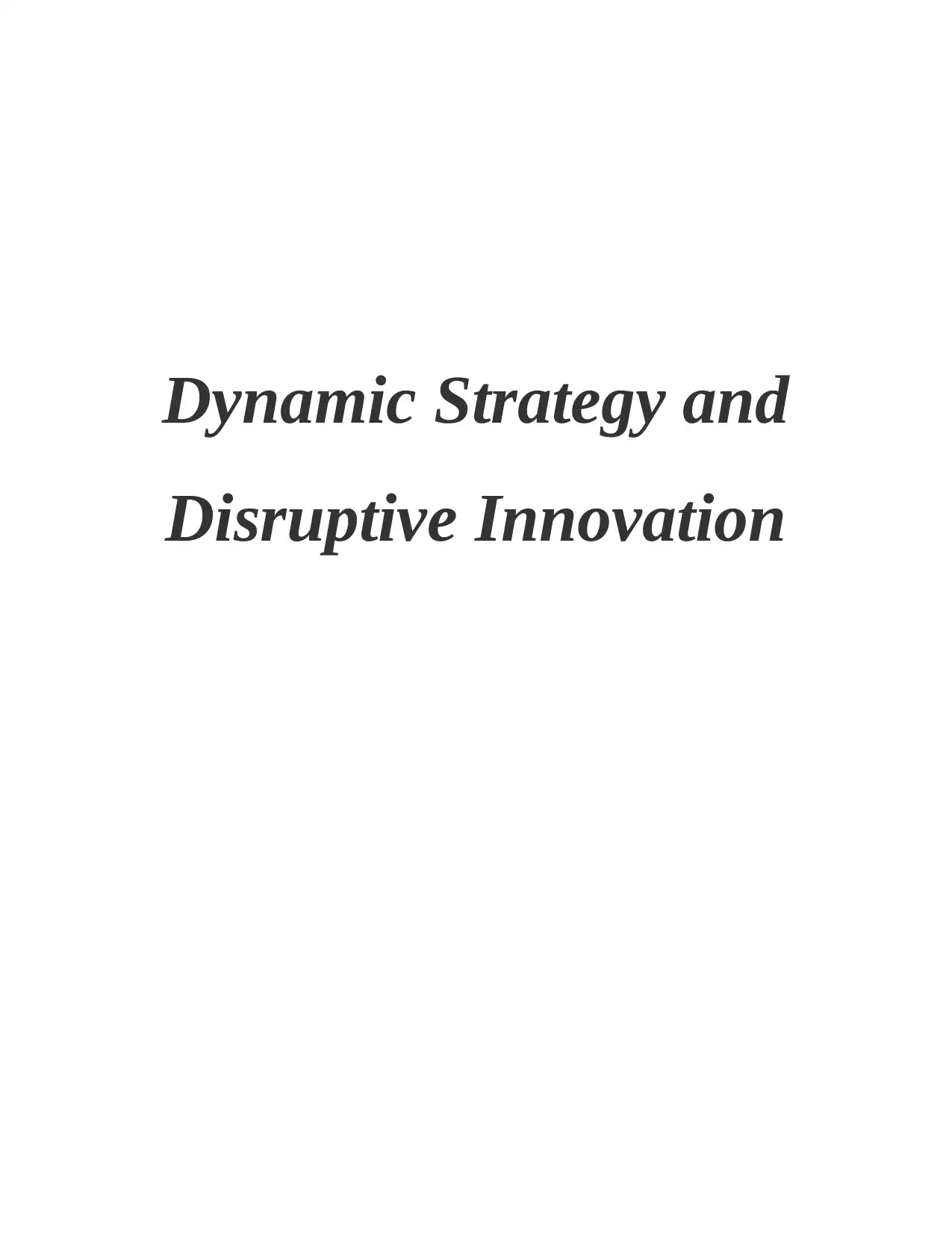
Dynamic Strategy and
Disruptive Innovation
Disruptive Innovation
Paraphrase This Document
Need a fresh take? Get an instant paraphrase of this document with our AI Paraphraser
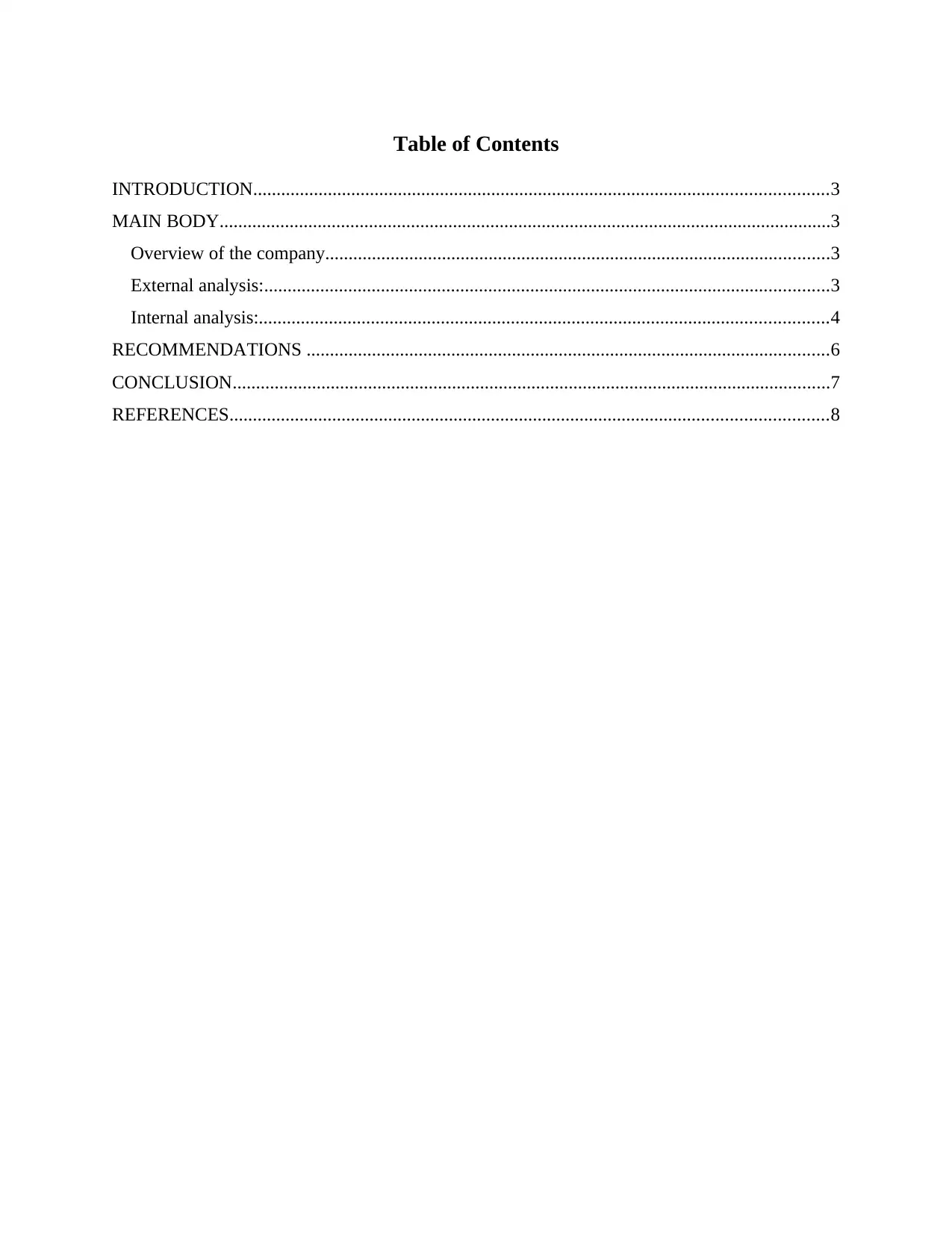
Table of Contents
INTRODUCTION...........................................................................................................................3
MAIN BODY...................................................................................................................................3
Overview of the company............................................................................................................3
External analysis:.........................................................................................................................3
Internal analysis:..........................................................................................................................4
RECOMMENDATIONS ................................................................................................................6
CONCLUSION................................................................................................................................7
REFERENCES................................................................................................................................8
INTRODUCTION...........................................................................................................................3
MAIN BODY...................................................................................................................................3
Overview of the company............................................................................................................3
External analysis:.........................................................................................................................3
Internal analysis:..........................................................................................................................4
RECOMMENDATIONS ................................................................................................................6
CONCLUSION................................................................................................................................7
REFERENCES................................................................................................................................8
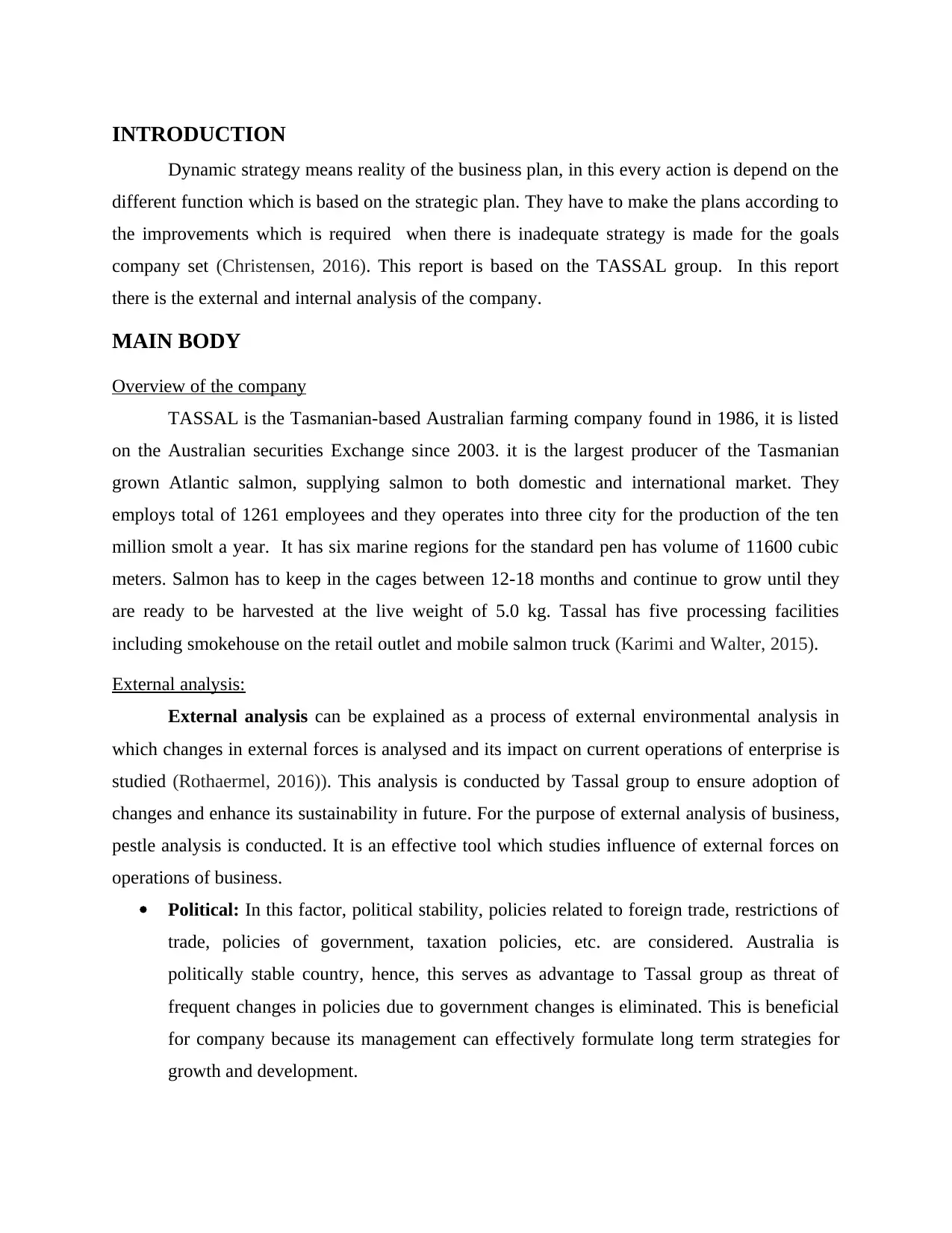
INTRODUCTION
Dynamic strategy means reality of the business plan, in this every action is depend on the
different function which is based on the strategic plan. They have to make the plans according to
the improvements which is required when there is inadequate strategy is made for the goals
company set (Christensen, 2016). This report is based on the TASSAL group. In this report
there is the external and internal analysis of the company.
MAIN BODY
Overview of the company
TASSAL is the Tasmanian-based Australian farming company found in 1986, it is listed
on the Australian securities Exchange since 2003. it is the largest producer of the Tasmanian
grown Atlantic salmon, supplying salmon to both domestic and international market. They
employs total of 1261 employees and they operates into three city for the production of the ten
million smolt a year. It has six marine regions for the standard pen has volume of 11600 cubic
meters. Salmon has to keep in the cages between 12-18 months and continue to grow until they
are ready to be harvested at the live weight of 5.0 kg. Tassal has five processing facilities
including smokehouse on the retail outlet and mobile salmon truck (Karimi and Walter, 2015).
External analysis:
External analysis can be explained as a process of external environmental analysis in
which changes in external forces is analysed and its impact on current operations of enterprise is
studied (Rothaermel, 2016)). This analysis is conducted by Tassal group to ensure adoption of
changes and enhance its sustainability in future. For the purpose of external analysis of business,
pestle analysis is conducted. It is an effective tool which studies influence of external forces on
operations of business.
Political: In this factor, political stability, policies related to foreign trade, restrictions of
trade, policies of government, taxation policies, etc. are considered. Australia is
politically stable country, hence, this serves as advantage to Tassal group as threat of
frequent changes in policies due to government changes is eliminated. This is beneficial
for company because its management can effectively formulate long term strategies for
growth and development.
Dynamic strategy means reality of the business plan, in this every action is depend on the
different function which is based on the strategic plan. They have to make the plans according to
the improvements which is required when there is inadequate strategy is made for the goals
company set (Christensen, 2016). This report is based on the TASSAL group. In this report
there is the external and internal analysis of the company.
MAIN BODY
Overview of the company
TASSAL is the Tasmanian-based Australian farming company found in 1986, it is listed
on the Australian securities Exchange since 2003. it is the largest producer of the Tasmanian
grown Atlantic salmon, supplying salmon to both domestic and international market. They
employs total of 1261 employees and they operates into three city for the production of the ten
million smolt a year. It has six marine regions for the standard pen has volume of 11600 cubic
meters. Salmon has to keep in the cages between 12-18 months and continue to grow until they
are ready to be harvested at the live weight of 5.0 kg. Tassal has five processing facilities
including smokehouse on the retail outlet and mobile salmon truck (Karimi and Walter, 2015).
External analysis:
External analysis can be explained as a process of external environmental analysis in
which changes in external forces is analysed and its impact on current operations of enterprise is
studied (Rothaermel, 2016)). This analysis is conducted by Tassal group to ensure adoption of
changes and enhance its sustainability in future. For the purpose of external analysis of business,
pestle analysis is conducted. It is an effective tool which studies influence of external forces on
operations of business.
Political: In this factor, political stability, policies related to foreign trade, restrictions of
trade, policies of government, taxation policies, etc. are considered. Australia is
politically stable country, hence, this serves as advantage to Tassal group as threat of
frequent changes in policies due to government changes is eliminated. This is beneficial
for company because its management can effectively formulate long term strategies for
growth and development.
⊘ This is a preview!⊘
Do you want full access?
Subscribe today to unlock all pages.

Trusted by 1+ million students worldwide
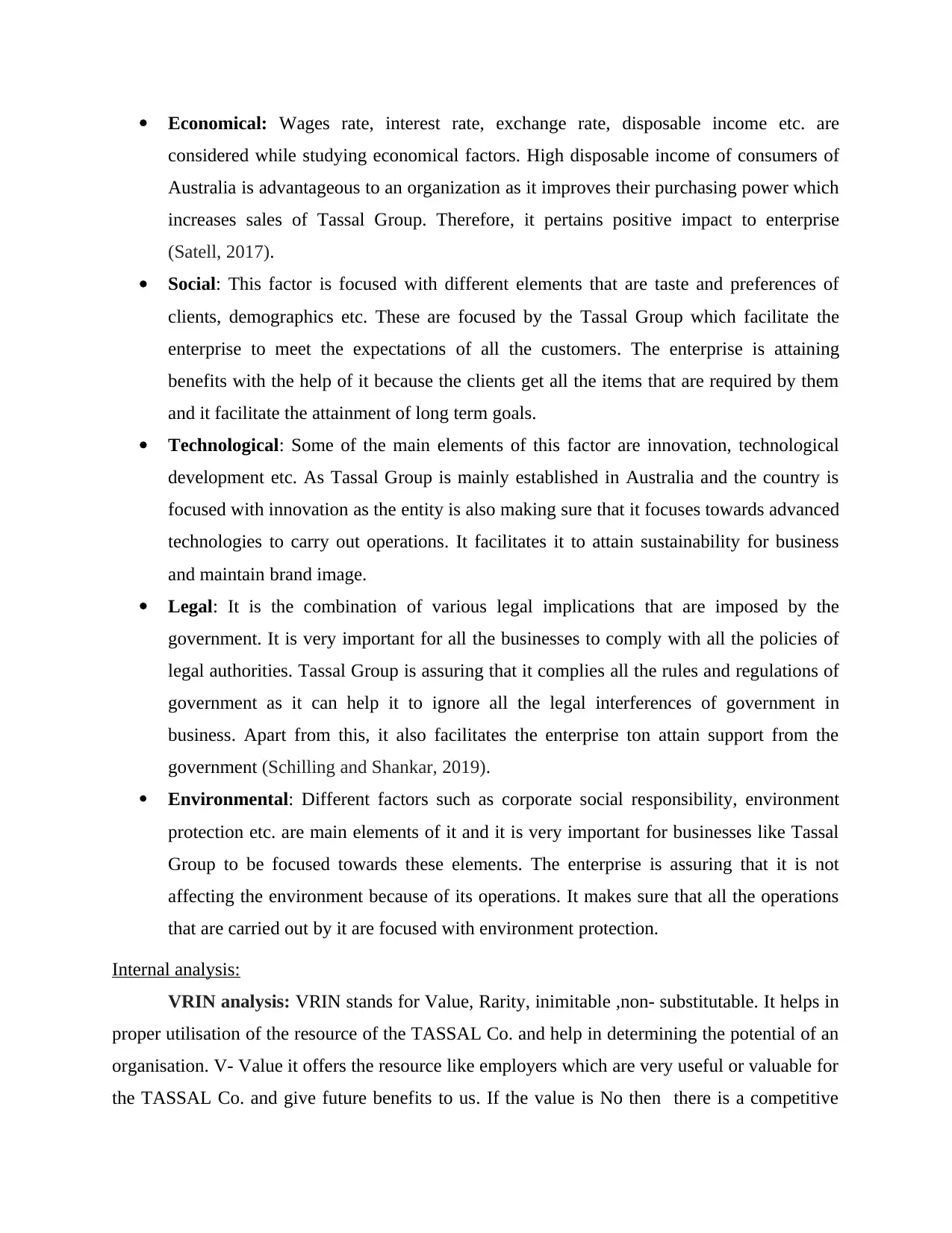
Economical: Wages rate, interest rate, exchange rate, disposable income etc. are
considered while studying economical factors. High disposable income of consumers of
Australia is advantageous to an organization as it improves their purchasing power which
increases sales of Tassal Group. Therefore, it pertains positive impact to enterprise
(Satell, 2017).
Social: This factor is focused with different elements that are taste and preferences of
clients, demographics etc. These are focused by the Tassal Group which facilitate the
enterprise to meet the expectations of all the customers. The enterprise is attaining
benefits with the help of it because the clients get all the items that are required by them
and it facilitate the attainment of long term goals.
Technological: Some of the main elements of this factor are innovation, technological
development etc. As Tassal Group is mainly established in Australia and the country is
focused with innovation as the entity is also making sure that it focuses towards advanced
technologies to carry out operations. It facilitates it to attain sustainability for business
and maintain brand image.
Legal: It is the combination of various legal implications that are imposed by the
government. It is very important for all the businesses to comply with all the policies of
legal authorities. Tassal Group is assuring that it complies all the rules and regulations of
government as it can help it to ignore all the legal interferences of government in
business. Apart from this, it also facilitates the enterprise ton attain support from the
government (Schilling and Shankar, 2019).
Environmental: Different factors such as corporate social responsibility, environment
protection etc. are main elements of it and it is very important for businesses like Tassal
Group to be focused towards these elements. The enterprise is assuring that it is not
affecting the environment because of its operations. It makes sure that all the operations
that are carried out by it are focused with environment protection.
Internal analysis:
VRIN analysis: VRIN stands for Value, Rarity, inimitable ,non- substitutable. It helps in
proper utilisation of the resource of the TASSAL Co. and help in determining the potential of an
organisation. V- Value it offers the resource like employers which are very useful or valuable for
the TASSAL Co. and give future benefits to us. If the value is No then there is a competitive
considered while studying economical factors. High disposable income of consumers of
Australia is advantageous to an organization as it improves their purchasing power which
increases sales of Tassal Group. Therefore, it pertains positive impact to enterprise
(Satell, 2017).
Social: This factor is focused with different elements that are taste and preferences of
clients, demographics etc. These are focused by the Tassal Group which facilitate the
enterprise to meet the expectations of all the customers. The enterprise is attaining
benefits with the help of it because the clients get all the items that are required by them
and it facilitate the attainment of long term goals.
Technological: Some of the main elements of this factor are innovation, technological
development etc. As Tassal Group is mainly established in Australia and the country is
focused with innovation as the entity is also making sure that it focuses towards advanced
technologies to carry out operations. It facilitates it to attain sustainability for business
and maintain brand image.
Legal: It is the combination of various legal implications that are imposed by the
government. It is very important for all the businesses to comply with all the policies of
legal authorities. Tassal Group is assuring that it complies all the rules and regulations of
government as it can help it to ignore all the legal interferences of government in
business. Apart from this, it also facilitates the enterprise ton attain support from the
government (Schilling and Shankar, 2019).
Environmental: Different factors such as corporate social responsibility, environment
protection etc. are main elements of it and it is very important for businesses like Tassal
Group to be focused towards these elements. The enterprise is assuring that it is not
affecting the environment because of its operations. It makes sure that all the operations
that are carried out by it are focused with environment protection.
Internal analysis:
VRIN analysis: VRIN stands for Value, Rarity, inimitable ,non- substitutable. It helps in
proper utilisation of the resource of the TASSAL Co. and help in determining the potential of an
organisation. V- Value it offers the resource like employers which are very useful or valuable for
the TASSAL Co. and give future benefits to us. If the value is No then there is a competitive
Paraphrase This Document
Need a fresh take? Get an instant paraphrase of this document with our AI Paraphraser
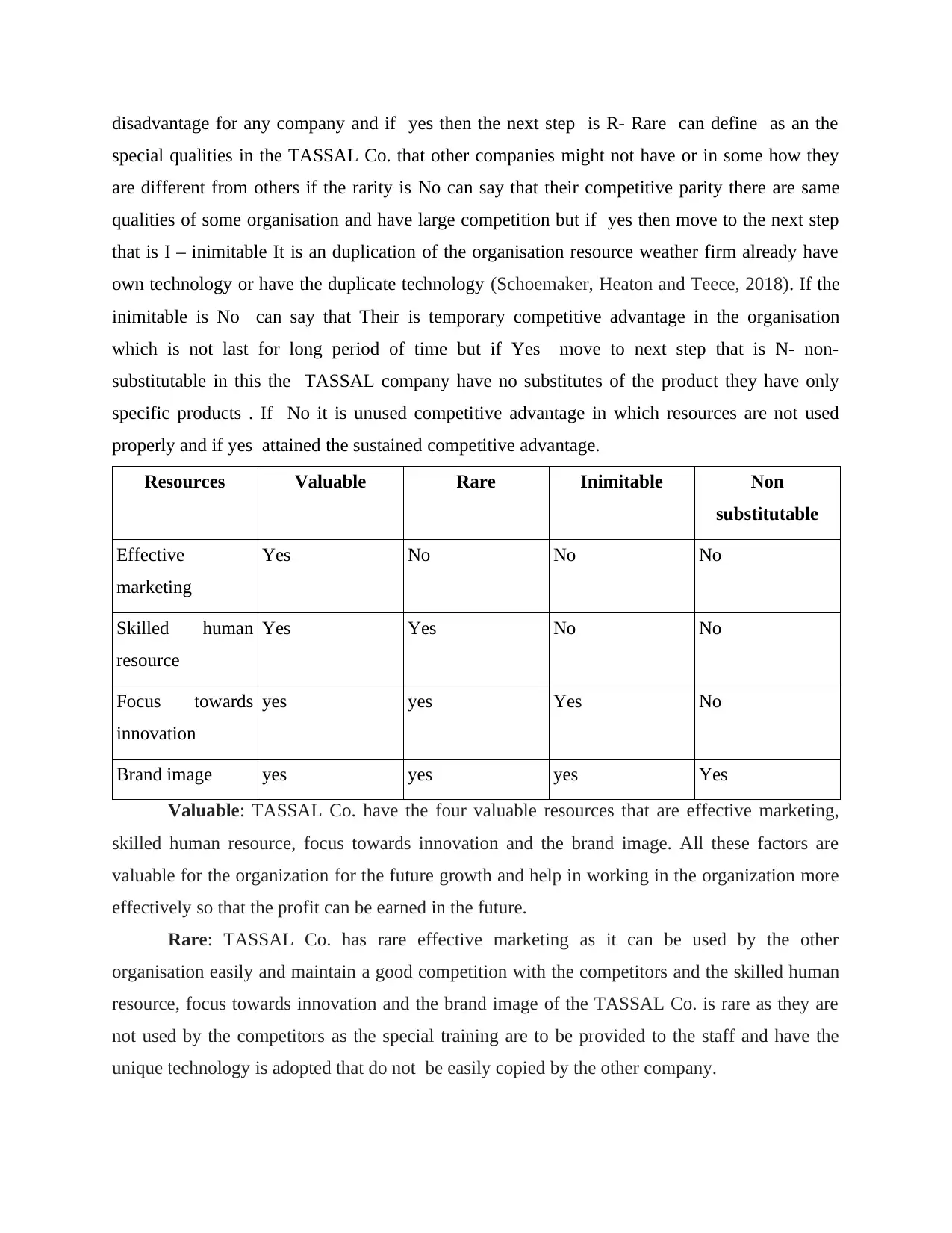
disadvantage for any company and if yes then the next step is R- Rare can define as an the
special qualities in the TASSAL Co. that other companies might not have or in some how they
are different from others if the rarity is No can say that their competitive parity there are same
qualities of some organisation and have large competition but if yes then move to the next step
that is I – inimitable It is an duplication of the organisation resource weather firm already have
own technology or have the duplicate technology (Schoemaker, Heaton and Teece, 2018). If the
inimitable is No can say that Their is temporary competitive advantage in the organisation
which is not last for long period of time but if Yes move to next step that is N- non-
substitutable in this the TASSAL company have no substitutes of the product they have only
specific products . If No it is unused competitive advantage in which resources are not used
properly and if yes attained the sustained competitive advantage.
Resources Valuable Rare Inimitable Non
substitutable
Effective
marketing
Yes No No No
Skilled human
resource
Yes Yes No No
Focus towards
innovation
yes yes Yes No
Brand image yes yes yes Yes
Valuable: TASSAL Co. have the four valuable resources that are effective marketing,
skilled human resource, focus towards innovation and the brand image. All these factors are
valuable for the organization for the future growth and help in working in the organization more
effectively so that the profit can be earned in the future.
Rare: TASSAL Co. has rare effective marketing as it can be used by the other
organisation easily and maintain a good competition with the competitors and the skilled human
resource, focus towards innovation and the brand image of the TASSAL Co. is rare as they are
not used by the competitors as the special training are to be provided to the staff and have the
unique technology is adopted that do not be easily copied by the other company.
special qualities in the TASSAL Co. that other companies might not have or in some how they
are different from others if the rarity is No can say that their competitive parity there are same
qualities of some organisation and have large competition but if yes then move to the next step
that is I – inimitable It is an duplication of the organisation resource weather firm already have
own technology or have the duplicate technology (Schoemaker, Heaton and Teece, 2018). If the
inimitable is No can say that Their is temporary competitive advantage in the organisation
which is not last for long period of time but if Yes move to next step that is N- non-
substitutable in this the TASSAL company have no substitutes of the product they have only
specific products . If No it is unused competitive advantage in which resources are not used
properly and if yes attained the sustained competitive advantage.
Resources Valuable Rare Inimitable Non
substitutable
Effective
marketing
Yes No No No
Skilled human
resource
Yes Yes No No
Focus towards
innovation
yes yes Yes No
Brand image yes yes yes Yes
Valuable: TASSAL Co. have the four valuable resources that are effective marketing,
skilled human resource, focus towards innovation and the brand image. All these factors are
valuable for the organization for the future growth and help in working in the organization more
effectively so that the profit can be earned in the future.
Rare: TASSAL Co. has rare effective marketing as it can be used by the other
organisation easily and maintain a good competition with the competitors and the skilled human
resource, focus towards innovation and the brand image of the TASSAL Co. is rare as they are
not used by the competitors as the special training are to be provided to the staff and have the
unique technology is adopted that do not be easily copied by the other company.
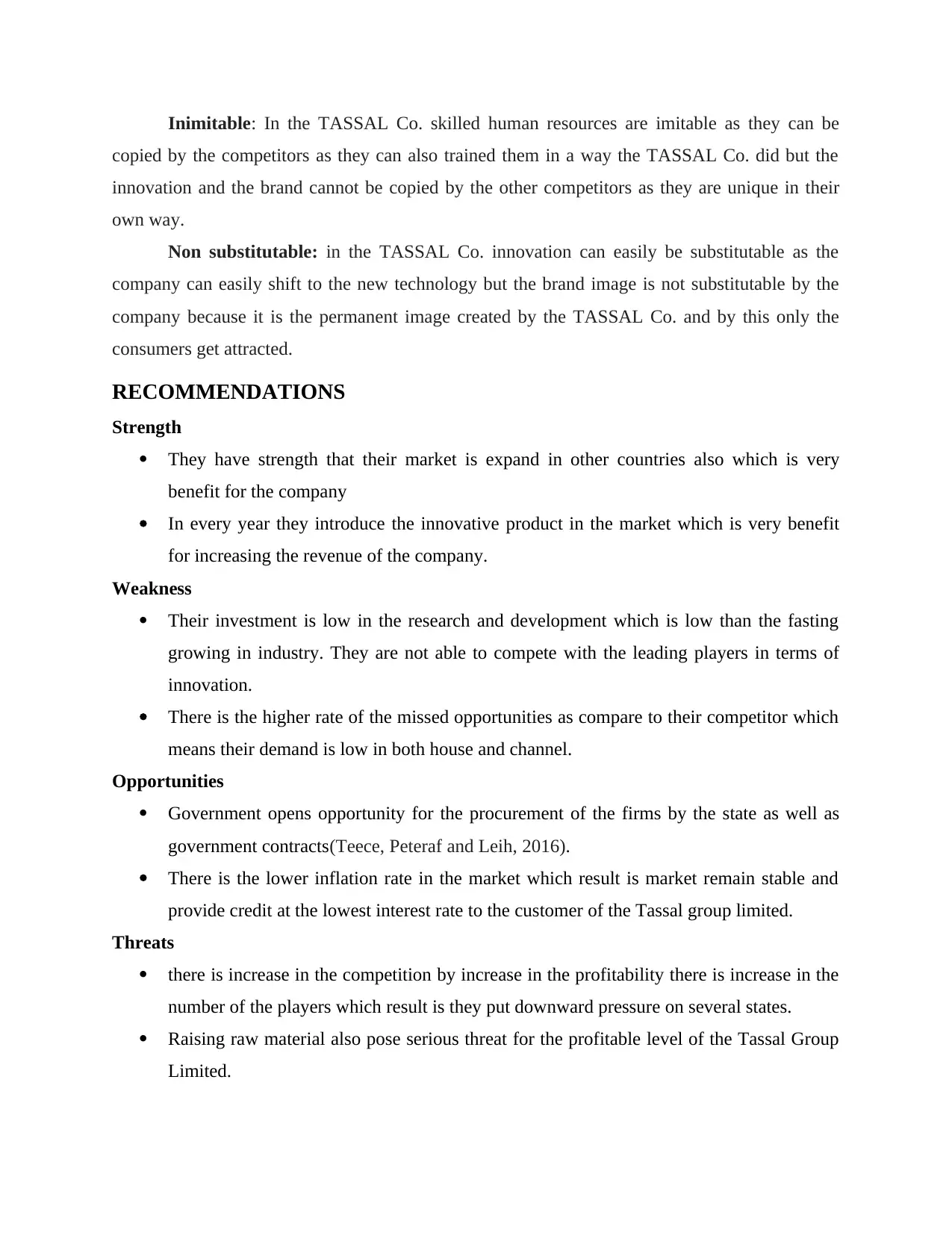
Inimitable: In the TASSAL Co. skilled human resources are imitable as they can be
copied by the competitors as they can also trained them in a way the TASSAL Co. did but the
innovation and the brand cannot be copied by the other competitors as they are unique in their
own way.
Non substitutable: in the TASSAL Co. innovation can easily be substitutable as the
company can easily shift to the new technology but the brand image is not substitutable by the
company because it is the permanent image created by the TASSAL Co. and by this only the
consumers get attracted.
RECOMMENDATIONS
Strength
They have strength that their market is expand in other countries also which is very
benefit for the company
In every year they introduce the innovative product in the market which is very benefit
for increasing the revenue of the company.
Weakness
Their investment is low in the research and development which is low than the fasting
growing in industry. They are not able to compete with the leading players in terms of
innovation.
There is the higher rate of the missed opportunities as compare to their competitor which
means their demand is low in both house and channel.
Opportunities
Government opens opportunity for the procurement of the firms by the state as well as
government contracts(Teece, Peteraf and Leih, 2016).
There is the lower inflation rate in the market which result is market remain stable and
provide credit at the lowest interest rate to the customer of the Tassal group limited.
Threats
there is increase in the competition by increase in the profitability there is increase in the
number of the players which result is they put downward pressure on several states.
Raising raw material also pose serious threat for the profitable level of the Tassal Group
Limited.
copied by the competitors as they can also trained them in a way the TASSAL Co. did but the
innovation and the brand cannot be copied by the other competitors as they are unique in their
own way.
Non substitutable: in the TASSAL Co. innovation can easily be substitutable as the
company can easily shift to the new technology but the brand image is not substitutable by the
company because it is the permanent image created by the TASSAL Co. and by this only the
consumers get attracted.
RECOMMENDATIONS
Strength
They have strength that their market is expand in other countries also which is very
benefit for the company
In every year they introduce the innovative product in the market which is very benefit
for increasing the revenue of the company.
Weakness
Their investment is low in the research and development which is low than the fasting
growing in industry. They are not able to compete with the leading players in terms of
innovation.
There is the higher rate of the missed opportunities as compare to their competitor which
means their demand is low in both house and channel.
Opportunities
Government opens opportunity for the procurement of the firms by the state as well as
government contracts(Teece, Peteraf and Leih, 2016).
There is the lower inflation rate in the market which result is market remain stable and
provide credit at the lowest interest rate to the customer of the Tassal group limited.
Threats
there is increase in the competition by increase in the profitability there is increase in the
number of the players which result is they put downward pressure on several states.
Raising raw material also pose serious threat for the profitable level of the Tassal Group
Limited.
⊘ This is a preview!⊘
Do you want full access?
Subscribe today to unlock all pages.

Trusted by 1+ million students worldwide
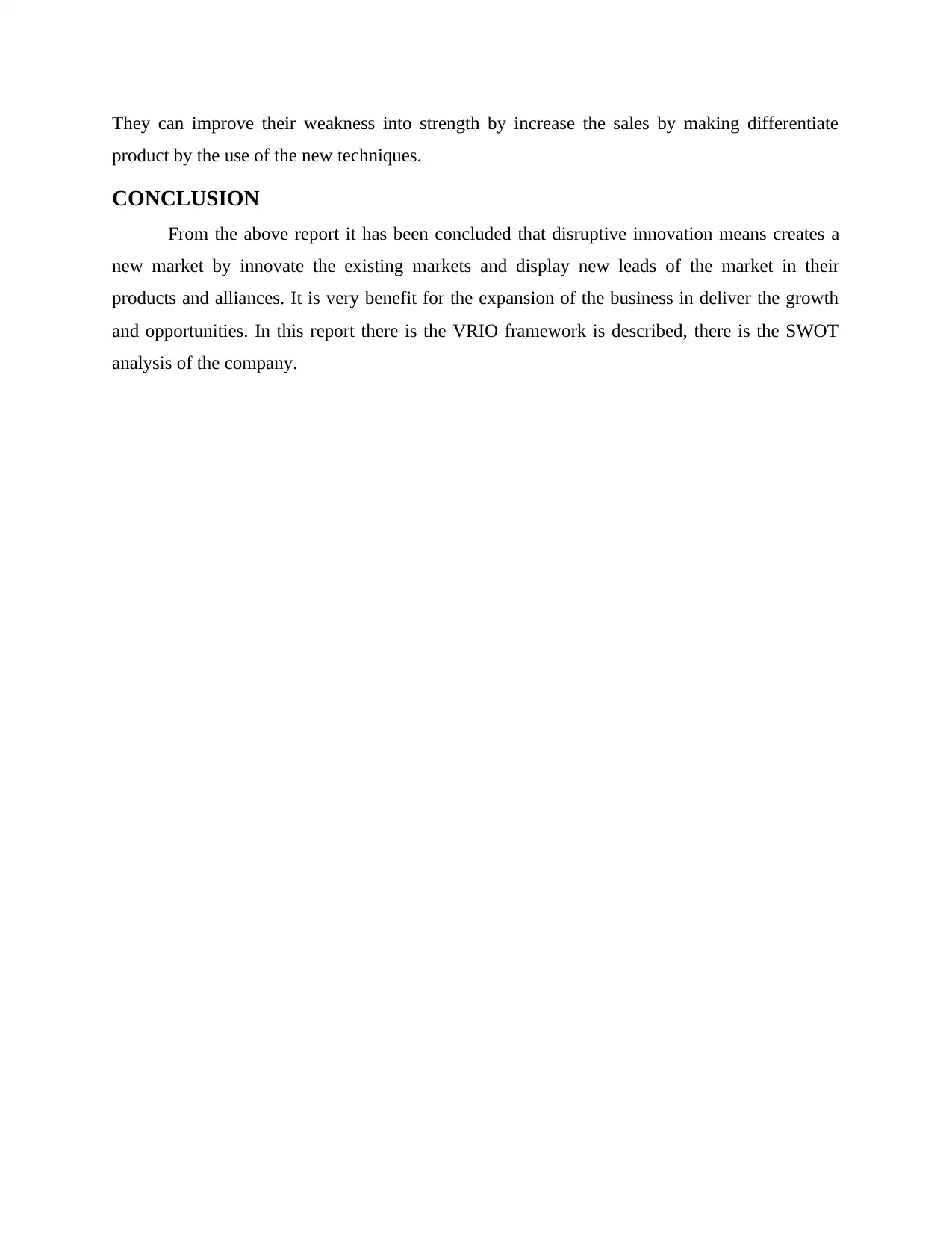
They can improve their weakness into strength by increase the sales by making differentiate
product by the use of the new techniques.
CONCLUSION
From the above report it has been concluded that disruptive innovation means creates a
new market by innovate the existing markets and display new leads of the market in their
products and alliances. It is very benefit for the expansion of the business in deliver the growth
and opportunities. In this report there is the VRIO framework is described, there is the SWOT
analysis of the company.
product by the use of the new techniques.
CONCLUSION
From the above report it has been concluded that disruptive innovation means creates a
new market by innovate the existing markets and display new leads of the market in their
products and alliances. It is very benefit for the expansion of the business in deliver the growth
and opportunities. In this report there is the VRIO framework is described, there is the SWOT
analysis of the company.
Paraphrase This Document
Need a fresh take? Get an instant paraphrase of this document with our AI Paraphraser
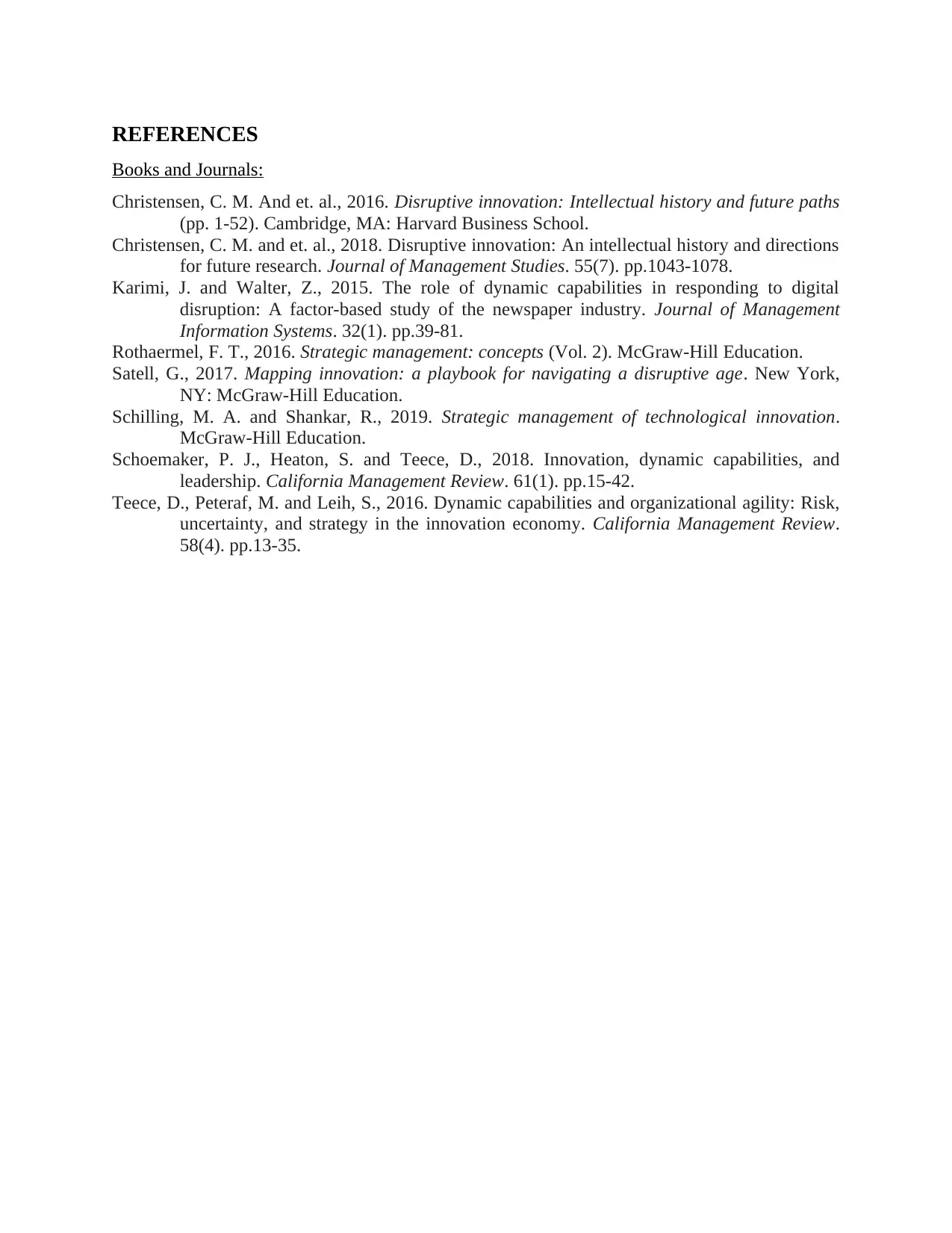
REFERENCES
Books and Journals:
Christensen, C. M. And et. al., 2016. Disruptive innovation: Intellectual history and future paths
(pp. 1-52). Cambridge, MA: Harvard Business School.
Christensen, C. M. and et. al., 2018. Disruptive innovation: An intellectual history and directions
for future research. Journal of Management Studies. 55(7). pp.1043-1078.
Karimi, J. and Walter, Z., 2015. The role of dynamic capabilities in responding to digital
disruption: A factor-based study of the newspaper industry. Journal of Management
Information Systems. 32(1). pp.39-81.
Rothaermel, F. T., 2016. Strategic management: concepts (Vol. 2). McGraw-Hill Education.
Satell, G., 2017. Mapping innovation: a playbook for navigating a disruptive age. New York,
NY: McGraw-Hill Education.
Schilling, M. A. and Shankar, R., 2019. Strategic management of technological innovation.
McGraw-Hill Education.
Schoemaker, P. J., Heaton, S. and Teece, D., 2018. Innovation, dynamic capabilities, and
leadership. California Management Review. 61(1). pp.15-42.
Teece, D., Peteraf, M. and Leih, S., 2016. Dynamic capabilities and organizational agility: Risk,
uncertainty, and strategy in the innovation economy. California Management Review.
58(4). pp.13-35.
Books and Journals:
Christensen, C. M. And et. al., 2016. Disruptive innovation: Intellectual history and future paths
(pp. 1-52). Cambridge, MA: Harvard Business School.
Christensen, C. M. and et. al., 2018. Disruptive innovation: An intellectual history and directions
for future research. Journal of Management Studies. 55(7). pp.1043-1078.
Karimi, J. and Walter, Z., 2015. The role of dynamic capabilities in responding to digital
disruption: A factor-based study of the newspaper industry. Journal of Management
Information Systems. 32(1). pp.39-81.
Rothaermel, F. T., 2016. Strategic management: concepts (Vol. 2). McGraw-Hill Education.
Satell, G., 2017. Mapping innovation: a playbook for navigating a disruptive age. New York,
NY: McGraw-Hill Education.
Schilling, M. A. and Shankar, R., 2019. Strategic management of technological innovation.
McGraw-Hill Education.
Schoemaker, P. J., Heaton, S. and Teece, D., 2018. Innovation, dynamic capabilities, and
leadership. California Management Review. 61(1). pp.15-42.
Teece, D., Peteraf, M. and Leih, S., 2016. Dynamic capabilities and organizational agility: Risk,
uncertainty, and strategy in the innovation economy. California Management Review.
58(4). pp.13-35.
1 out of 8
Related Documents
Your All-in-One AI-Powered Toolkit for Academic Success.
+13062052269
info@desklib.com
Available 24*7 on WhatsApp / Email
![[object Object]](/_next/static/media/star-bottom.7253800d.svg)
Unlock your academic potential
Copyright © 2020–2025 A2Z Services. All Rights Reserved. Developed and managed by ZUCOL.





